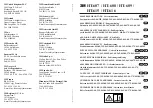
Instruction manual
Page 48 / 189
Copyright © REA Elektronik
REA JET HR
pro
2K / 4K
V 3.5x_001 28.05.2015
Opening for the product sensors offered by REA JET:
All REA JET HR stripper plates have an oval opening (2). Based on the opening for the cartridge,
this opening is located at the opposite side like the protective milled edge. The opening is designed
to accommodate the proper functionality of the standard photoelectric sensor as well as the laser
sensor and the print mark sensor (to detect colors).
The side of the stripper plate on which the oval opening for the product sensor is located is also
known as the inlet side.
Symmetric design:
Generally, the installation of the print head with the stripper plate must allow for the product to first
pass the oval opening for the product sensor and the nozzle plate of the cartridge. The symmetric
design of the RES JET HR stripper plate enables assembly with the opening for the product sensor
on the left as well as on the right side. By turning the stripping plate by 180 degrees, the installation
can be easily adapted to an altered product direction.
Additional guide wheel:
On the back side of each REA JET HR stripper plate, two M4 blind hole threads are installed in the
area of the inlet side (3) as well as the outlet side (4). An additional guide wheel can be fastened on
each of the thread pairs. For stationary installation, this guide wheel is usually required only on the
inlet side (3). In most cases, e.g. the marking of flexible bagged goods or hand marker, we
recommend the additional use of a guide wheel at the outlet side (4). You can find further
information on this in chapter 3.2.2.2.5.
Figure 29: Back side of the REA JET HR stripper plate, single
The two M4 blind hole threads (4) on the back side in the outlet
side area are only available for components delivered from March
2013.
Ground bolts:
An M5 threaded bolt is pressed into the back side of each REA JET HR stripper plate (in the outlet
side area). This threaded bolt is used to connect a cable to the functional grounding / conductance
of potential "interference fields". You can find further information on this in chapter 4.2.18.2.
4
3
5
















































